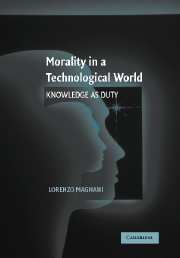Book contents
- Frontmatter
- Contents
- Preface
- 1 Respecting People as Things: Environment
- 2 Treating People as Means: Cloning
- 3 Hybrid People, Hybrid Selves: Artifacts, Consciousness, Free Will
- 4 Knowledge as Duty: Cyberprivacy
- 5 Freedom and Responsibility: Bad Faith
- 6 Creating Ethics: Good Reasons and Good Arguments
- 7 Inferring Reasons: Practical Reasoning, Abduction, Moral Mediators
- Afterword
- References
- Index
3 - Hybrid People, Hybrid Selves: Artifacts, Consciousness, Free Will
Published online by Cambridge University Press: 18 July 2009
- Frontmatter
- Contents
- Preface
- 1 Respecting People as Things: Environment
- 2 Treating People as Means: Cloning
- 3 Hybrid People, Hybrid Selves: Artifacts, Consciousness, Free Will
- 4 Knowledge as Duty: Cyberprivacy
- 5 Freedom and Responsibility: Bad Faith
- 6 Creating Ethics: Good Reasons and Good Arguments
- 7 Inferring Reasons: Practical Reasoning, Abduction, Moral Mediators
- Afterword
- References
- Index
Summary
… we must see the need of having nonviolent gadflies to create the kind of tension in society that will help men to rise from the dark depths of prejudice and racism to the majestic heights of understanding and brotherhood.
Martin Luther King, Jr., “Letter from the Birmingham City Jail”In a considerable part of traditional moral philosophy, machines (and things) are thought of as means having only instrumental value, whereas people are considered ends in themselves, entities with more highly regarded intrinsic value; as we have discussed, the Kantian ideal is that people should be accorded greater worth than things. But the real world, unfortunately, is not an ideal world, and current human value systems often rank some aspects of things above certain people; intrinsic value does not always trump instrumental value. Clearly, then, the old ways of thinking no longer serve us well, and they become even less relevant as modern technology continues to blur the distinction between human beings and machines and as people acquire ever more thing-like characteristics.
The prospect of people's becoming more thing-like may seem troubling, but I contend that it need not diminish the status of human beings; on the contrary, I believe it can improve conditions for many people around the world. If things are accorded great value, it behooves us to identify the thing-like qualities of human beings so that they too can enjoy such value. But how do we compare things to people? What are the relationships between the two?
- Type
- Chapter
- Information
- Morality in a Technological WorldKnowledge as Duty, pp. 52 - 92Publisher: Cambridge University PressPrint publication year: 2007



